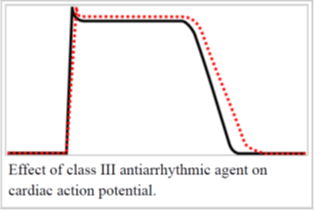Drugs acting on Potassium channels
Ion Channels
- Ion channels are protein molecules that form pores on the plasma membrane and intracellular organelle of all cells.
- Responsible for transfer of ions
- Regulate the shape and frequency of Action potential
- Potassium channels form most abundant and diverse class of ion channels
- They are membrane spanning proteins allowing efflux of potassium ions through K+ selective pore.
- Their activity may be regulated by voltage, calcium, or neurotransmitters
- Play important role in cellular and cardiac repolarization, smooth muscle relaxation, neurotransmitter and insulin release.
There are four major classes of potassium channels:
Calcium-activated potassium channel – open in response to the presence of calcium ions or other signalling molecules.
Inwardly rectifying potassium channel – passes current (positive charge) more easily in the inward direction (into the cell).
Tandem pore domain potassium channel – are constitutively open or possess high basal activation, such as the “resting potassium channels” or “leak channels” that set the negative membrane potential of neurons.
Voltage-gated potassium channel – are voltage-gated ion channels that open or close in response to changes in the transmembrane voltage.
Modulators of K channels
Blockers
- Sulfonylureas and meglitinides
- block the accessory subunit SUR 1 located on the inward-rectifier KATP channel, causing intracellular K+ accumulation, depolarization and opening of voltage dependent calcium channels (VDCCs), causing insulin release
- Naturally occurring toxins à Strychinine
- Class III antiarrhythmics à Amiodarone, Dofetilide, Sotalol

- block the potassium channels, thereby prolonging repolarization
- The prolongation of the action potential duration and refractory period, combined with the maintenance of normal conduction velocity, prevent reentrant arrhythmias
- Class III antiarrhythmic agents exhibit reverse use dependent prolongation of the action potential duration (Reverse use dependence).
- This means that the refractoriness of the ventricular myocyte increases at lower heart rates.
- This increases the susceptibility of the myocardium to Early After depolarizations (EADs) at low heart rates.
- Antiarrhythmic agents that exhibit reverse use dependence are more efficacious at preventing a tachyarrhythmia than converting someone into normal sinus rhythm.
- Because of the reverse use dependence of class III agents, at low heart rates class III antiarrhythmic agents may paradoxically be more arrhythmogenic
- Amiodarone should only be used to treat adults with life threatening ventricular arrhythmias when other treatments are ineffective or have not been tolerated
- Sotalol is indicated for the treatment of atrial or ventricular tachyarrhythmias, and AV reentrant arrhythmias.
- Ibutilide is the only antiarrhythmic agent currently approved by the Food and Drug Administration for acute conversion of atrial fibrillation to sinus rhythm.
- Vernakalant- It blocks K+, fast Na+ current à It is effective for AF of short duration, not recommended
- Dalfampridine à approved for use in the treatment of multiple sclerosis
Openers
- Adenosine, prostacyclin
- VIP, CGRP, NO
- Diazoxide à vasodilator used for hypertension, smooth muscle relaxing activity
- Minoxidil à vasodilator used for hypertension, also used to treat hair loss
- Nicorandil à vasodilator used to treat angina
- Retigabine, Ezogabine à an anticonvulsant
- Flupirtine à analgesic with muscle relaxant and anticonvulsant properties
MOA of potassium channel openers
Potassium channel openers à Open KATP à Enhance K+ efflux à Membrane Hyperpolarization
↓ Ca 2+ entry à Reduced intracellular calcium à Smooth muscle relaxation
Screening of drugs for activity on potassium channels.
8.1 Patch clamp technique
Screening of drugs for activity on potassium channels.
8.1 Patch clamp technique
Screening of drugs for activity on potassium channels.
8.1 Patch clamp technique
Screening of drugs for activity on potassium channels
- Patch clamp technique
- Ligand displacement assays
- Flux assays
